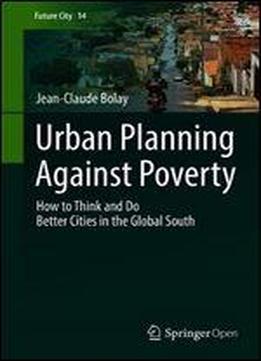
Urban Planning Against Poverty: How To Think And Do Better Cities In The Global South
by Jean-Claude Bolay /
2019 / English / PDF
18.4 MB Download
Urbanism is a reality that goes back, as a human institution, to the history of mankind that has gradually been appropriated in terms of its description, its analysis and its projection, by a range of scientific disciplines, technical knowledge and humanistic visions, which tend to highlight its morphology, its occupation, and the diverse forms of socio-spatial interaction that it entails. A crucial reflection must be posed with high priority when it comes to cities located in emerging and developing countries in particular with respect to small and medium-sized cities. Overall, these are the areas that suffer the highest rates of population growth it is their authorities who suffer most from the lack of financial and human resources to be able to anticipate and address these issues. These are the societies, at local and regional levels, who pay the consequences in terms of human and material precariousness, contamination of natural resources, informalization of economic activities, and malfunction in the process of decision-making and governance. And it is this urbanization that will in the coming decades be put under increasing pressure, knowing that 95% of urban growth will primarily impact emerging and developing countries. Hence the question whether there is indeed spatial and social urban planning, appropriate to these contexts and able to resolve the issues confronted by the stakeholders. As a subsidiary question, is it not wise to challenge the models to which these planning measures refer, in order to substitute logic and measures that restore coherence between theories and their concepts, public and private practices, and the strategies that they reflect. This in favor of a redefinition of the objectives of urban planning in emerging and developing countries, methods to be implemented, tools and techniques applied to rectify them, and interventions emerging in the field by public, private, and collective stakeholders, engaged in these processes of change of urban issues. This open access book revisits the theoretical foundations of urban planning and the application of these concepts and methods in the context of Southern countries by examining several case studies from different regions of the world. For instance, the case of Koudougou, a medium-sized city in one of the poorest countries in the world, Burkina Faso, with a population of 115.000 inhabitants, allows us to understand concretely which and how these deficiencies are translated in an African urban context. In contrast, the case of Nueve de Julio, intermediate city of 50.000 dwellers in the pampa Argentina, addresses the new forms of spatial fragmentation and social exclusion linked with agro export and crisis of the international markets. Case studies are also included for cities in Asia and Latin America. Differences and similarities between cases allow us to foresee alternative models of urban planning better adapted to tackle poverty and find efficient ways for more inclusive cities in developing and emerging countries, interacting several dimensions linked with high rates of urbanization: territorial fragmentation environmental contamination social disparities and exclusion, informal economy and habitat, urban governance and democracy.











